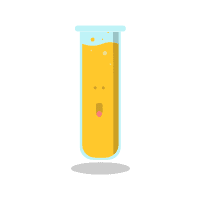
Topic: 5.5 Matter and Energy
Quiz by Grade 5 Science - Texas Education Agency
Grade 5
Science (2010) (Archived)
Texas Essential Knowledge and Skills (TEKS)
Feel free to use or edit a copy
includes Teacher and Student dashboards
Measures 4 skills from
Measures 4 skills from
Track each student's skills and progress in your Mastery dashboards
With a free account, teachers can
- edit the questions
- save a copy for later
- start a class game
- automatically assign follow-up activities based on students’ scores
- assign as homework
- share a link with colleagues
- print as a bubble sheet
33 questions
Show answers
- Q1Which of these is the best conductor of electricity?Copper pennyPlastic tubingCotton stringGlass rod60s5.5.A: Matter and Energy
- Q2A teacher mixes a white powder into a beaker of water. The powder cannot be seen in the water. The teacher then heats the mixture until the water evaporates and the powder can be seen again. Which property of the powder is the teacher demonstrating?MassDensitySolubilityConductivity60s5.5.A: Matter and Energy
- Q3A student measures the temperature of water being heated on a hot plate. The student observes that the temperature of the water is 53°C. How many more degrees Celsius must the temperature rise before it reaches the boiling temperature of water? Be sure to use the correct place value.Users enter free textType an Answer60s5.5.B: Matter and Energy
- Q4A mixture of beads was placed in a container, as shown below. The beads are of various sizes, and each one is made of plastic, glass, or steel. The mixture would be easy to separate because all the beads —are attracted to a magnetare solidshave the same massare less dense than water60s5.5.C: Matter and Energy
- Q5A teacher sets up an experiment using five jars like the ones shown below. The teacher keeps one jar unwrapped as the control. The other four jars are wrapped with equal thicknesses of four different materials. The jars are each filled with an equal amount of water that is 92°C. Students observe and record the water temperature in each jar after 10 minutes. The results are shown in the table below. Which property of the materials wrapping the jars are the students most likely investigating?Ability to conduct electricityState of matterThermal energy productionThermal energy insulation60s5.5.A: Matter and Energy
- Q6A student reads the label on the bottle of salad dressing shown below. Why would the student shake the salad dressing well before using it?Vinegar and oil have different densities.Vinegar and oil easily form a solution.Vinegar and oil are both liquids.Vinegar and oil both contain water.60s5.5.A: Matter and Energy
- Q7A worker built a sidewalk and pressed some large salt particles into the concrete while it was still wet. When the concrete was dry, the worker washed the sidewalk with water. The picture below shows the sidewalk after it was washed. What most likely happened to the salt?It dissolved in the water.It evaporated into a gas.It turned into concrete.It turned into a solid.60s5.5.D: Matter and Energy
- Q8A student observes ice forming on the edge of a school building. At what temperature did the water outside the school building most likely begin to change to ice?32°C25°C0°C100°C60s5.5.B: Matter and Energy
- Q9Which of these is not soluble in water?HoneyOilSugarSalt60s5.5.A: Matter and Energy
- Q10A student measures the mass of several substances and records the results in the table below. What is the difference in grams between the total mass of the liquid substances and the total mass of the solid substances used in the investigation? Be sure to use the correct place value.Users enter free textType an Answer60s5.5.A: Matter and Energy
- Q11When a powdered drink mix was added to water, the liquid turned orange. A student decided the taste was too strong, so he poured out half of the liquid and added more water. Which of the following most likely occurred when more water was added?None of the aboveThe orange color became lighter.The physical state changed.The liquid had a sweeter taste.60s5.5.D: Matter and Energy
- Q12A teacher wears protective gloves to lift a metal pan filled with boiling water from a hot plate. Why are the protective gloves necessary?The metal pan conducts thermal energy.The metal pan creates thermal energy.The metal pan insulates thermal energy.The metal pan reduces thermal energy60s5.5.A: Matter and Energy
- Q13A student made a mixture using equal amounts of salt and pepper. The salt grains were the same size as the pepper grains. What should the student do to most easily separate the pepper from the salt?Use a strainer with a fine wire screen to remove the pepperRun a small magnet through the mixture to attract the pepperPut the mixture in water and filter the pepper out of the waterUse a pair of tweezers to remove each grain of pepper60s5.5.C: Matter and Energy
- Q14Objects that blow into a swimming pool or that are dropped into the pool by swimmers need to be removed. These objects include foam cups, keys, and coins. Which of the following explains a useful method for removing some of these objects?The keys and coins have the same density as water, so they can be washed away when the pool is drained.The foam cups are less dense than water, so they can be removed from the surface with a pool cleaning net.The keys and coins are less dense than water, so they can be easily picked up off the bottom of the pool by divers.The foam cups have the same density as water, so they can be crumbled up for removal by the pool filter.60s5.5.A: Matter and Energy
- Q15A cook uses the ingredients listed below to prepare a meal. Which table correctly shows the physical properties of these ingredients when placed in hot water?#texas/7169d962-9468-4161-8f19-886caafe5d8b/A.png#texas/7169d962-9468-4161-8f19-886caafe5d8b/C.png#texas/7169d962-9468-4161-8f19-886caafe5d8b/D.png#texas/7169d962-9468-4161-8f19-886caafe5d8b/B.png60s5.5.A: Matter and Energy